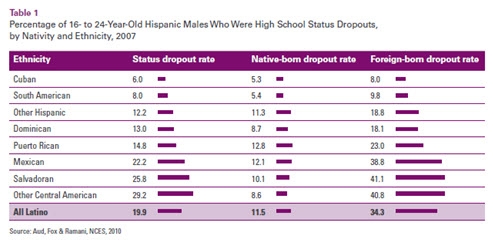Nearly half of young men of color age 15 to 24 who graduate from high school will end up unemployed, incarcerated or dead.
The reports, The Educational Experience of Young Men of Color: A Review of Research, Pathways and Progress highlight that in order to once again become the leader in degree attainment, the United States will need to produce about 13.4 million additional college degrees by the year 2020. Reaching this college attainment goal will require significant participation and contributions by all racial/ethnic groups.

As of 2008, only 41.6 percent of 25- to 34-year-olds in the United States had attained an Associate degree or higher. More alarmingly, only 30.3 percent of African Americans and 19.8 percent of Latinos ages 25 to 34 had attained an associate degree or higher in the United States, compared to 49.0 percent for white Americans and 70.7 percent for Asian Americans.
On the other hand, the Latino dropout rates show that the average dropout rate does not always tell the whole story. For example, in 2007 the 6.0 percent dropout rate for Cuban males is well below the Latino average of 19.9 percent, while the Salvadoran dropout rate is much higher at 25.8 percent.
The report concludes there is an educational crisis for young men of color in the United States. Men, especially minority men, lag behind their female counterparts in college access, educational attainment and employment.
The postsecondary pathways data show that 10 percent of African American males, 3 percent of Asian American males, 5 percent of Hispanic males and 3 percent of Native American males are incarcerated. Prisons and jails have become a significant destination for African American and Hispanic males.
Source: College Board, Advocacy Policy Center,”The Educational Experience of Young Men of Color: a Review of Research, Pathways and Progress”, June 2011.